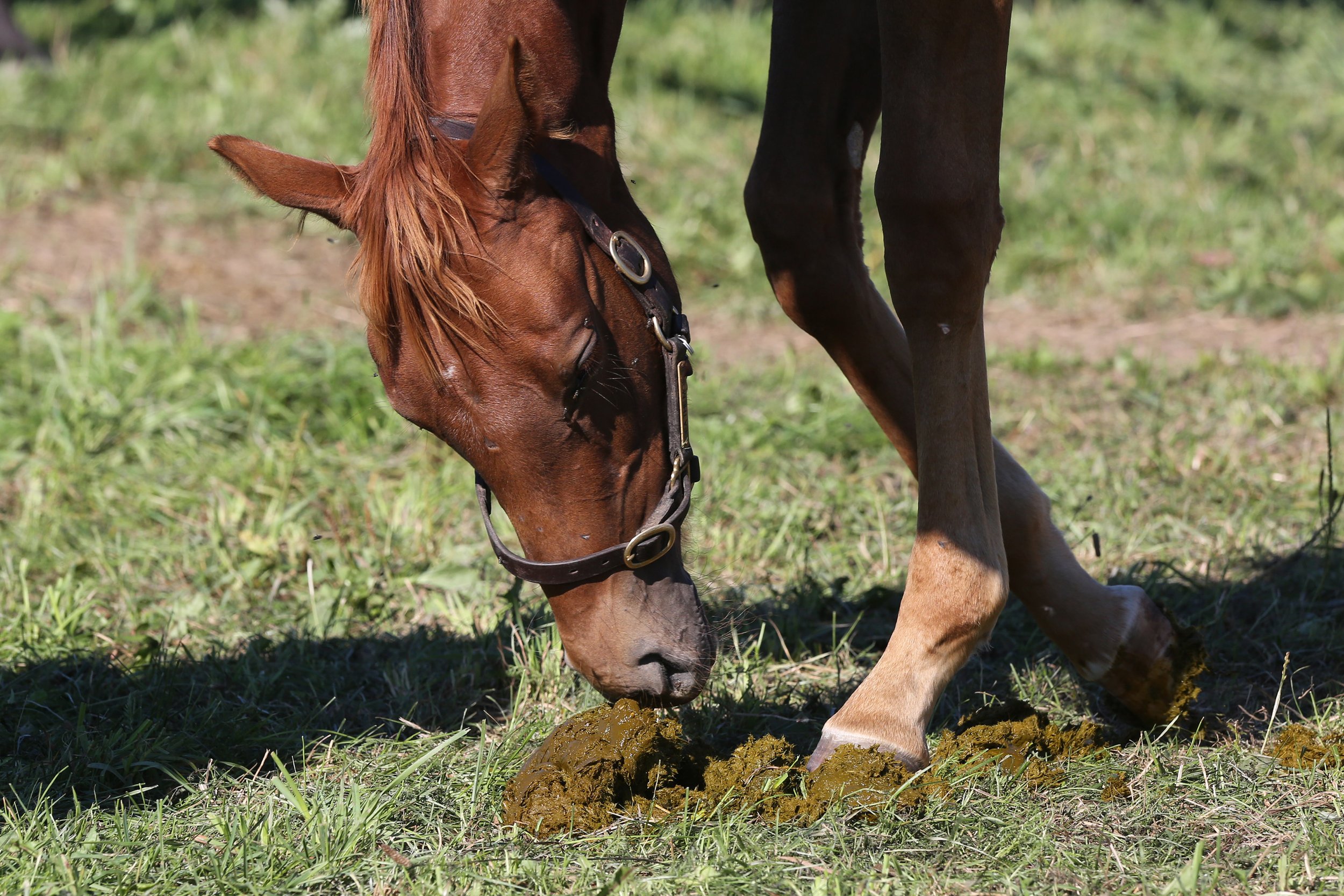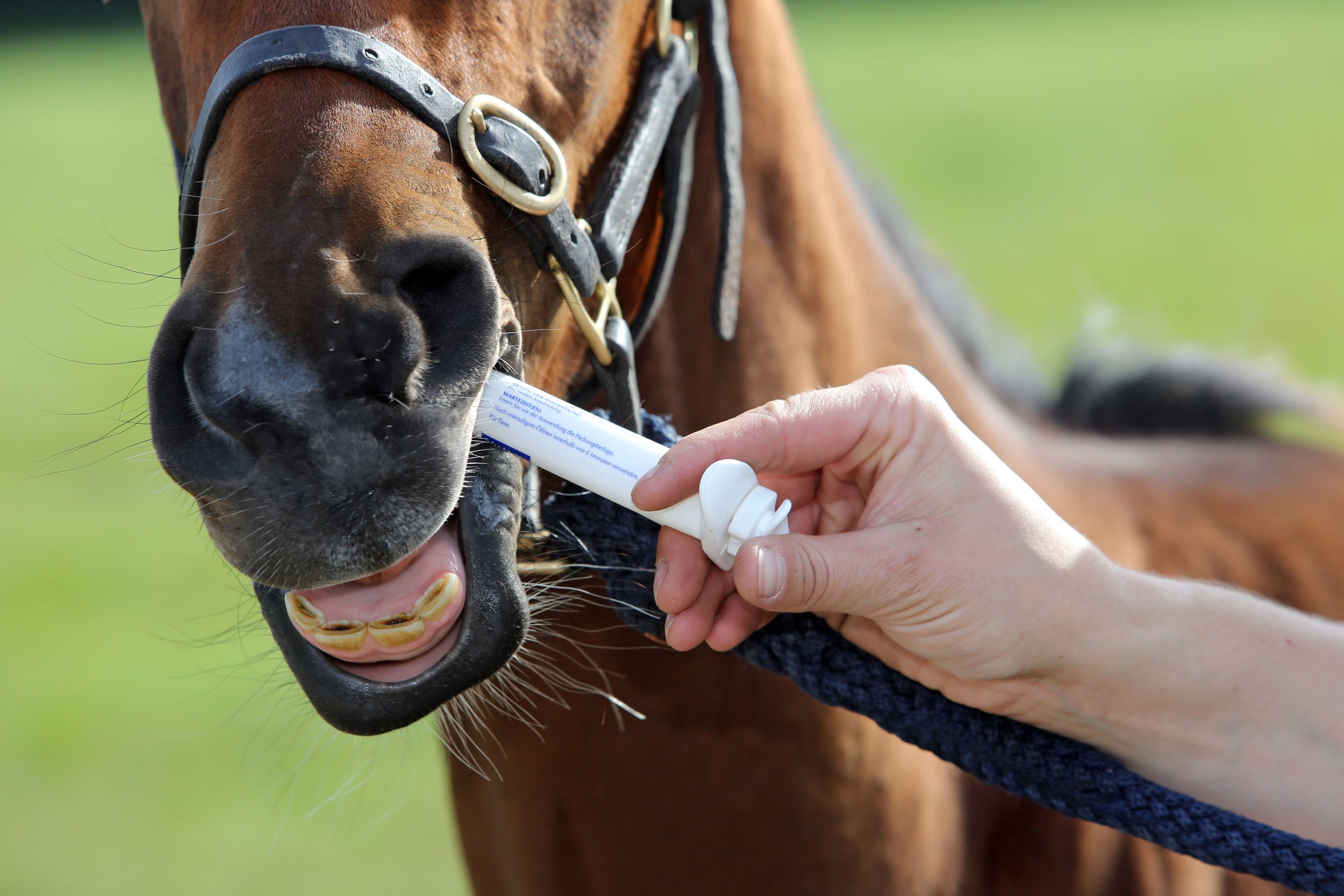Addressing drug resistance in equine tapeworms
/Article by Jacqui Matthews
Tapeworms are important parasites of horses
All horses can be infected with internal parasitic worms, which can cause health issues, including weight loss, diarrhoea, and colic. The most common worms affecting racehorses, and other horses, are the small strongyles (cyathostomins) and the common equine tapeworm, Anoplocephala perfoliata. Horses are infected by ingesting parasites from contaminated grazing, whether it be a field, turn-out paddock or opportunistic grazing on training grounds or racetracks.
Recent reports of dewormer resistance in A. perfoliata are very concerning, especially as there are few available products to treat these parasites and no new drugs are expected to enter the market soon. These relatively large parasites typically reside at the junction of the small and large intestines and can cause colic. The worms attach in clusters to the intestinal wall, which can cause mechanical obstruction and mucosal damage.
Blockages can cause impaction, potentially necessitating surgery. Moreover, the presence of tapeworms may lead to intussusception, where one segment of the intestine telescopes into an adjacent segment, also requiring surgery. Studies indicate that having as little as 20 tapeworms can cause significant damage to the intestinal wall (Pavone et al. 2010). Therefore, it is crucial to prevent such burdens from accumulating in horses.
Tapeworm resistance to deworming products
There are two types of dewormers (anthelmintics) available for treating tapeworms: praziquantel and pyrantel (given at double the dose used for treating roundworms). In the UK and EU, there have been several anecdotal reports of reduced effectiveness of anti-tapeworm drugs. A recent research study on a Thoroughbred farm in the US evaluated the performance of both tapeworm dewormers (Nielsen, 2023).
The results demonstrated treatment failures in foals and broodmares in which tapeworms survived treatment. This was the first formal report of suspected drug resistance in tapeworms. Resistance occurs when parasites survive deworming treatments and pass on reduced sensitivity to the drugs to subsequent generations. Repeated treatments with the same drug can lead to parasite burdens that cannot be cleared and may result in clinical disease.
Given the threat of resistance in this species, it is essential to reduce the overuse of anti-tapeworm medications. Implementing more sustainable control methods is now crucial for the long-term effectiveness of these important dewormers. These control methods must include:
maintaining a clean grazing environment
regularly monitoring parasite burdens
deworming only those horses that truly need treatment.
Use grazing management methods to reduce reliance on dewormers
Tapeworms differ from other common equine worms because they develop inside mite intermediate hosts on paddocks (Fig. 1). Horses become infected when they consume hay or grass that contains tapeworm-infected mites. Mites are infected by eating eggs passed in the dung of infected horses. Where horses have access to grazing paddocks, it is essential to remove dung daily and dispose of it well away from both the grazing area and any water sources. Extra caution should be taken with horses that have grazed away from the yard and newcomers to the yard (see quarantine recommendations below).
Use tests to reduce dewormer treatment frequency
Regular testing is essential for effectively managing tapeworm infections. Faecal egg count (FEC) tests are unsuitable for detecting tapeworms. These detect worm eggs shed in dung, but are not reliable indicators of the overall parasite burden in individuals, particularly since immature worms are not detected. FEC methods are also influenced by the variable release of egg-containing segments from adult tapeworms.
The main purpose of FEC tests in tapeworm control is to assess the effectiveness of deworming treatments. If tapeworm eggs are detected in dung samples taken two weeks after treatment, this is a significant finding. However, the absence of eggs in a FEC does not mean that tapeworms are not present. If resistance is suspected, this should be discussed with a veterinary surgeon.
Tests that measure antibodies to tapeworm provide valuable information about levels of infection and should be used to guide treatment decisions. Antibody tests are available in blood and saliva formats. In the blood test, samples are collected by a veterinary surgeon and sent to the laboratory for analysis.
This test measures levels of tapeworm-specific antibodies in the blood, with results reported back to the veterinary surgeon as "serum scores." These scores are categorised as low, borderline, or moderate/high, and treatment is recommended for horses with results in the borderline or moderate/high categories. The non-invasive saliva test involves taking a sample from the horse’s mouth using a specially developed swab (Fig. 3) and does not require a veterinary surgeon.
The swab containing the saliva sample is mailed to the laboratory in a preservative solution, ensuring stability for at least three weeks. At the laboratory, the saliva sample is assessed using a special three-ELISA system that accurately measures tapeworm-specific antibodies, with the results reported as “saliva scores”. Similar to the blood test, the saliva test categorises results as low, borderline, or moderate/high, with treatment recommended for horses that have results in the second two categories. Because antibodies take time to decrease after effective treatment, horses should not be tested again until 4 months after the last deworming for blood tests or 3 months for saliva tests.
By reliably detecting tapeworm burdens, antibody tests enable treatments to be targeted to only those horses that need treating and therefore reduce the risk of dewormer resistance. Results from tapeworm testing have led to significant reductions in the use of dewormers; from 2015 to 2022, over 164,000 horses in the UK were assessed using the saliva test, with only one-third recommended for treatment (Matthews et al. 2024).
Applying tapeworm testing at racing yards
Tapeworm testing frequency can be determined by conducting a risk assessment. Key risk factors include age and access to contaminated grass, as well as historical test results. These parasites can be long-lived and persist for extended periods, so it is essential to consider each horse’s history during or before training.
While most horses in training are at low risk due to having limited pasture access, yearlings and two-year-olds may have higher burdens, especially if from breeding farms or other premises where there is a high level of infection. However, all ages of horses are susceptible to tapeworms. Regular assessments with a veterinary surgeon will also identify risk factors in yard management practices, including those associated with activities like short daily turnouts. A comprehensive risk assessment will:
1. Identify which tests to perform (FEC tests, small redworm blood tests, tapeworm tests) and the frequency of testing
2. Highlight the need for treatments for high-risk horses when tests do not provide information for treatment decisions
3. Provide information on worm exposure and ways to minimise infection risks.
If significant risks are detected, such as a high level of tapeworm infection indicated by testing or the frequent introduction of new horses, testing should occur every six months. Once a year testing may be appropriate in low-risk situations where previous testing has shown low evidence of tapeworm infection.
Testing identifies infected horses that could spread infection to others, allowing for prompt treatment and reducing the risk of colic. If many horses test positive, it is crucial to identify the source of infection and improve management practices to reduce spread. In a recent case study on a UK training yard, 56 horses were tested for tapeworm antibodies.
The results revealed that only 14% of the horses had tapeworm burdens that required treatment. These horses were turned out in a small paddock for just 30 minutes each day, and because dung was not removed from the area, the paddock was identified as a source of infection. The trainer was advised to remove the dung from the paddock daily and to treat any horses that tested positive for tapeworms.
This testing protocol not only helped reduce the overall deworming frequency, but also provided the trainer with valuable information about horses at risk of colic. It also highlighted potential areas for improving parasite management practices.
Avoiding the introduction of new or resistant worms
Introducing new horses to racing yards requires proper assessment to determine if they have roundworm (small redworm, ascarid) or tapeworm infections. The traditional method of treating all newcomers with a broad-spectrum dewormer is outdated and should be avoided due to increasing drug resistance in all common parasites. Instead, it is recommended to assess new horses using appropriate tests, specifically;
FEC tests to identify if they are shedding eggs such as small redworm and ascarid eggs
Blood tests to detect small redworm stages that may not be detected using FEC tests
Tapeworm tests to identify horses that need specific treatment for this parasite.
If any of these tests return positive results, the appropriate dewormer can be selected to target the parasites present. Furthermore, if a horse tests positive in the initial FEC test, it is advisable to conduct a follow-up FEC test two weeks after treatment to determine whether the dewormer has been effective.
In conclusion
Every horse will encounter parasitic worms at some point in their life, making effective parasite control essential for their health and well-being. While traditional all-group dewormer treatments have been common, rising cases of dewormer resistance reveal that this approach is no longer sustainable, especially as no new anti-tapeworm treatments are expected soon.
Using tapeworm tests to determine if treatment is needed is crucial to maintain the effectiveness of existing dewormers. Many horses in low-risk environments have minimal or no tapeworm infections, making regular treatments unnecessary. Testing helps identify only those horses that truly need treatment, thus promoting the longer-term efficacy of dewormers.
In the racing industry, there is significant overuse of dewormers, with few trainers using evidence-based practices. It is essential that the spread of resistant worms is prevented, especially as racehorses move to various environments (breeding farms, sport horse yards, sanctuaries, leisure horse premises) where more vulnerable horses may reside. For this reason, the industry must adopt management-based and test-led methods to control worm populations effectively.
References
Matthews et al. 2024. In Practice 46:34-41.
Nielsen. 2023. Int J Parasitol Drugs Drug Resist. 22, 96-101.
Pavone et al. 2010. Vet. Res. Commun. 34, S53-6.











